
Where Are We Now? – David Bowie
Sitting in the Dschungel….on Nürnbergerstrasse…
a man lost in time…near KaDeWe..
just walking the dead…
15th July 2015. I’ve taken a weekend break in Berlin because I’ve been in a hotel in Prague for months. And it was pure chance that I stumbled on the key to unlock this song. It becomes the second in an occasional and hopefully enjoyable series of “inside the song” – the first one was Rufus Wainwright’s The Art Teacher (see My Pop Life #16) and a trip round the Metropolitan Museum. This time we’re inside David Bowie’s Berlin some 38 years ago, via a song that was released in 2013.
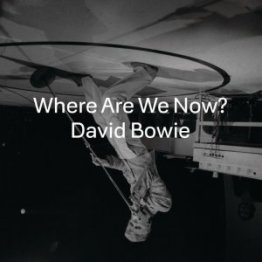
Where Are We Now? was dropped without fanfare or PR by David Bowie (after a ten-year absence with no new music) on the occasion of his 66th birthday on 8th January 2013. All the musicians (mainly Bowie regulars like Gail Ann Dorsey, Earl Slick and Gerry Leonard) were sworn to secrecy, and the rest of us marvelled that soon we would have an entirely new David Bowie LP – The Next Day – to pore over, one month later. But this song just blew me away. Vintage Bowie, but more than that, essential Bowie, a piece of the introspective jigsaw puzzle, a lament for a younger artist, a divided city, a deeply sad reflection on ageing, consumerism, freedom, what lasts and what doesn’t. What remains after all these years of glory ? The new LP cover deliberately spelled out what was going on – the cover of 1977’s “Heroes” with a blank white space covering its centre.
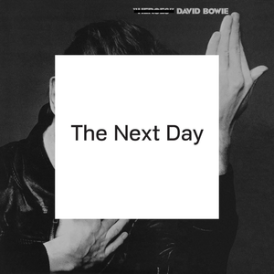
So what exactly is going on here? Going where Ashes To Ashes had previously explored, (referencing a previous Bowie incarnation Major Tom), this is still daring, exposed and naked, and is for me one of the greatest songs in Bowie’s career, and would indeed be a compulsory question in the David Bowie A-level. Why ? It’s all about Berlin – where he made arguably his three greatest albums from 1976-78 : Low, Heroes and Lodger (a period I discussed with some embarrassment in My Pop Life #54), and also a place where he actually lived for a long period. An interesting, important place. It’s also a song about David Bowie, the man. The human. Much of this song is mysterious, some of it is right on the nose. Let’s break it down. First see the lyric quote above… One of the strange words is :
KaDeWe
a word that all Berliners will instantly understand but which I stumbled over on my unplanned free day in Berlin. I’d just bought a pair of Pumas in the sale (€30!) because my fabulous Czech Botas had turned out to be made of pain and after six days I couldn’t take it any more. The large mixed-race German man in the Puma shop told me I could buy leather stretcher for them, but I explained that they were vegan shoes – no leather. “Ah” he said, “then that is concomitant. Is that a word?” His English was better than mine. “It means for example that I eat meat and I wear leather shoes. If you kill an animal it’s better to use everything and not waste it“. He was incredibly clear. I was feeling foolish but he was kind. “Will you keep the Czech shoes?” he asked. “I will wear the new ones out of the store” I replied, “I cannot walk another second in the Botas. They look great, they’re killing me.” I carried the Botas out in the Puma carrier bag. It was red and comforting.
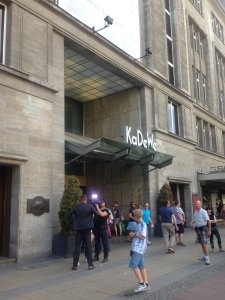
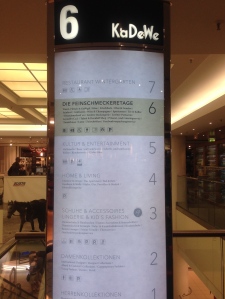
Outside, new shoes – Fashion – turn to the right – I drifted along the street and saw a man being interviewed by a reporter as a crowd gawped outside what I thought was a hotel. I checked the hotel name. KaDeWe. Just walking the dead. My spine shivered gently. Where Are We Now ? It was a shop. But KaDeWe is more than just “a shop”. I could see Gucci, Dior, Bulgari. It feels like Harrods or Selfridges. Clothes, yes. Electronics. Jewellry. Perfume. Food and drink : A wooden map of where your malt whisky comes from. Pastries. Organic meat and cheese. Newspapers from all corners of the world. Rich. Red Money. Things you couldn’t buy in East Berlin in 1977. I took escalators up, up, up to the 6th floor and the Konditorei. Found a table and ordered Kaffee mit Shokolade und Schlagsahne and rice pudding with cinnamon (!) slightly warm. It felt like a German choice of essen. From the window seat I could see the broken spire of Kaiser Wilhelm Gedächtniskirche, the symbol of post-war Berlin, and the Mercedes HQ, symbol of the people who shop at KaDeWe.
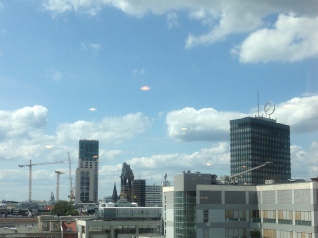
I sang the song gently to myself and sipped my coffee. Sitting in the Dschungel… Right. I would do the song today. I would trace David Bowie’s Berlin footsteps via this song. And I would do it without wifi since Berlin is bad at wifi and my phone wasn’t having it either. Old school. Maps plus intuition. What could possibly go wrong?
Outside I found a free wifi portal – hold the front page – “I would do it without wifi” – with a dirty unbreakable smeared screen made of perspex that I had to stab repeatedly with my finger. OCD wouldn’t have made it past this obstacle. I found a reference to the Dschungel which looked like a club of some kind, on Nürnbergerstrasse. This would be my next stop. I studied the map and failed to find it. No information booths anywhere. My finger was tired of stabbing the perspex so I hailed a cab. “Nürnbergerstrasse bitte“. He swung the car round. “Welcher nummer?” Shit I hadn’t retained that piece of information. We drove one whole block back and onto Nürnbergerstrasse. He dropped me one block down. A journey of two whole minutes. No Dschungel. I turned around and walked back up the street to the ZoologischeGarten. No Dschungel. Balls. I would have to walk back to the free robot wifi.
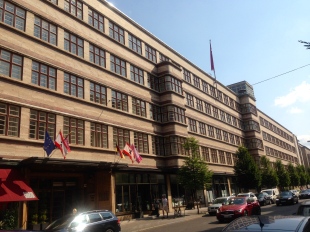 Found it, stabbed it again. My page was still up. Nummer 53. Drei und funfzig. I walked back round to Nürnbergerstrasse. In the centre of the strasse was a huge art deco building called The Ellington Hotel.
Found it, stabbed it again. My page was still up. Nummer 53. Drei und funfzig. I walked back round to Nürnbergerstrasse. In the centre of the strasse was a huge art deco building called The Ellington Hotel.
It straddled what would have been #53. I entered into a strange, tiled, otherworldly, almost sanatorium-esque atmosphere where the white-clad employees smiled and everything was lovely. “Excuse me – did there used to be a club called Dschungel here?“. “Yes“. Bingo. She explained that Duke Ellington himself and other jazz greats used to frequent the cellar bar Badewane back in the late 40s, before it became the Dschungel, a place where Frank Zappa, Prince and Bowie and Iggy Pop would host parties, rivalling Studio 54 for glamour in the late 70s.

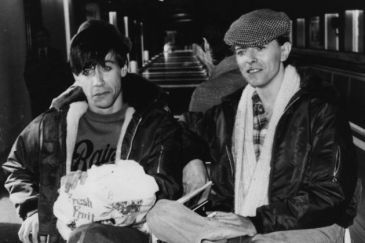
…a man lost in time…
David’s recollection of it all is melancholic, a man trying to enjoy himself in the midst of dislocation. But he thrived on dislocation, and he knew it. Through the 1970s he would lay down a new style, a new look, a new sound then quickly change shape and reappear just as the mice in their million hordes were forming groups to follow his “latest” thing. Lennon’s on sale again. He had to keep moving to create, and he knew it. So many of his songs are about “tomorrow” – sci-fi dystopias, from Oh You Pretty Things to Drive-In Saturday, Diamond Dogs to Moonage Daydream and Starman. The other favourite theme is the surreal Postcard from the Edge of somewhere else, somewhere new. Autobiographical, confessional, compulsive, mythological, introspective – Ziggy Stardust, Ashes To Ashes, Jean Genie, Station To Station, Always Crashing In The Same Car, The Bewlay Brothers, Afraid, in fact it could be argued that as he progressed Bowie’s songs have become more and more personal.

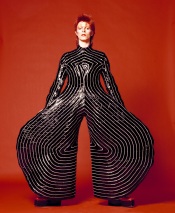
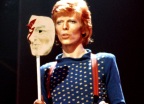
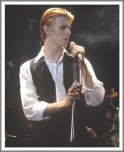
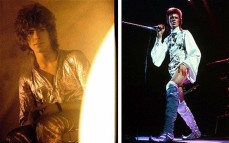

Bowie’s move to West Berlin came after the cocaine-addicted Los Angeles period of Station To Station, an LP which also lays claim to being his best, but which was produced under extreme conditions of drug-fuelled stress. West Berlin was in 1976 an artistic, capitalist, symbolic western enclave surrounded by a Communist state – the DDR or Deutsche Demokratische Republik. East Germany. Created by Churchill, Roosevelt and Stalin after WW2, the city of West Berlin was surrounded by a Wall, with various armed crossing points complete with barbed wire, no-man’s land and soldiers. The famous one was called Checkpoint Charlie (referenced in Elvis Costello’s Oliver’s Army) which Jenny and I had crossed in late December 1989 just as the Wall was being chipped away at and broken down from both sides (see My Pop Life #166 Pacific 202). We still had to show passports, get a short visa and return within six hours. Berlin was divided but not for long. On New Year’s Eve we stood on the Wall with millions of tourists who’d had the same idea as us and felt the weight of history. Just for one day. I’ll blog that trip properly another day though.
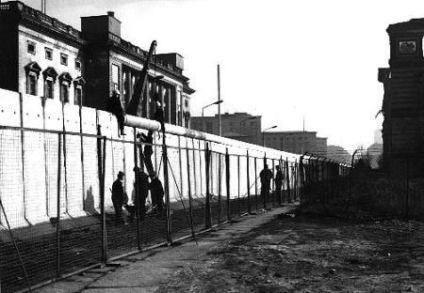
Hansa Studios and The Wall, 1970s
David Bowie recorded at Hansa Studios, where he could see the Wall. Traces of the Wall still remain, now protected by city ordinance, a tourist attraction, but most of it has been flattened and redeveloped.
Had to take the train from Potsdamer platz….you never knew that
…that I could do that
just walking the dead…

Die Mauer
So my next target was Potsdamer Platz. Again no wifi, the map defeated me – but there was Potsdam at the end of the S7 line I’d already used from Alexanderplatz. So I jumped on board and took the S7 to Potsdam which took about 35 minutes. Maybe more. It’s to the southwest of Berlin, like Richmond. It immediately didn’t feel like a place that David Bowie would get on a train, but who knows right? I got off and went to INFO where I was told to go back and get on an S1.
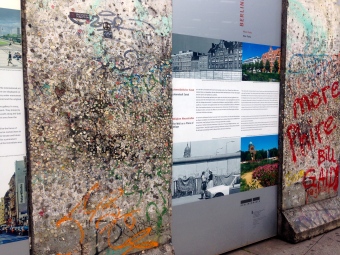 On the way back the map confirmed that a schoolboy error had occurred. Potsdamer Platz is just to the south of Brandenburg Tor, and just to the north of Hansa Studios, right in the centre of town. Of Course. I disembark finally at Potsdamer Platz and there is an ugly piece of the wall remaining just outside the station, covered in chewing gum, which is even worse than those padlocks you find on bridges all over Europe. Graffitti yes. But chewing gum? Draw the blinds on yesterday and its all so much scarier. I walked to Brandenburg Gate (which is splendid and dull) and back through Tiergarten (frisbees and statues) to Potsdamer Platz where there are three stations – Deutsche-Bahn, U-bahn and S-bahn. Which one did David use ? And why was it such a big deal for him – to mention it in a song? Maybe he was off to Paris to see a girlfriend. Maybe he never took trains, ever. Taxi man. Of course in those days you couldn’t get a train across the city, from Potsdamer Platz you could only go one way – west.
On the way back the map confirmed that a schoolboy error had occurred. Potsdamer Platz is just to the south of Brandenburg Tor, and just to the north of Hansa Studios, right in the centre of town. Of Course. I disembark finally at Potsdamer Platz and there is an ugly piece of the wall remaining just outside the station, covered in chewing gum, which is even worse than those padlocks you find on bridges all over Europe. Graffitti yes. But chewing gum? Draw the blinds on yesterday and its all so much scarier. I walked to Brandenburg Gate (which is splendid and dull) and back through Tiergarten (frisbees and statues) to Potsdamer Platz where there are three stations – Deutsche-Bahn, U-bahn and S-bahn. Which one did David use ? And why was it such a big deal for him – to mention it in a song? Maybe he was off to Paris to see a girlfriend. Maybe he never took trains, ever. Taxi man. Of course in those days you couldn’t get a train across the city, from Potsdamer Platz you could only go one way – west.
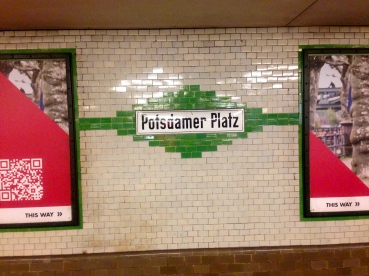
I gave my Puma box containing Czech Botas to a drunken beggar woman sitting at the top of the subway steps. She seemed interested as I turned away and walked down underground to the U train east back to Alexanderplatz happy that I’d been there at least, and then took a tram back to the hotel ackselhaus. I was staying in Prenzlauer Berg for the weekend – a visitor from Prague where I am working all summer. Prenzlauer Berg is a newly gentrified quarter of old East Berlin, lovely old buildings, tramlines, cafes, pubs, near my friend Maria von Heland whom I’d met in Sweden at Amanda Ooms’ 50th birthday (see My Pop Life #14). Amanda was in Berlin with her boyfriend Joakim Thåström, Swedish rock star and reconnected childhood sweetheart, he’d had a gig with his band the night before at Postbahnhof in the middle of a 40-degree heatwave which became a huge thunderstorm as he played.
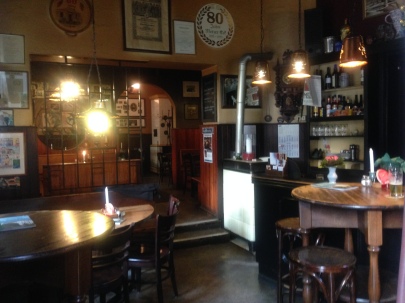
I had a quick beer, then went round the corner to a local pub Metzer Ebb which Maria had told me has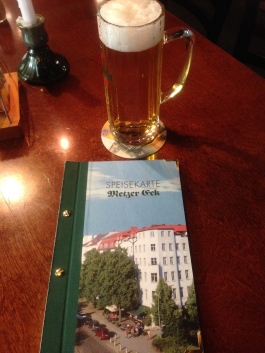 remained unchanged since the days of the DDR. I ordered Knackwurst und Kartoffelnsalate mit senf and drank a giant beer, was told I could take pictures but not with people in. They were ladies in their 50s, friendly but not overly so. They would have been 25 when the wall came down and Germany was re-unified. The pub wall was covered in old black and white pictures, the wood was dark stained oak, the fittings and cigarette machines from a bygone era. I loved it of course. The knackwurst mit senf (mustard) was perfect and the potato salad had paprika and gherkin mixed into it. Where Are We Now?
remained unchanged since the days of the DDR. I ordered Knackwurst und Kartoffelnsalate mit senf and drank a giant beer, was told I could take pictures but not with people in. They were ladies in their 50s, friendly but not overly so. They would have been 25 when the wall came down and Germany was re-unified. The pub wall was covered in old black and white pictures, the wood was dark stained oak, the fittings and cigarette machines from a bygone era. I loved it of course. The knackwurst mit senf (mustard) was perfect and the potato salad had paprika and gherkin mixed into it. Where Are We Now?
Amanda and Maria still hadn’t called me (I later discovered that iMessages don’t reach your phone unless you’re on wifi) so I had two dinners and put on the headphones to listen to David’s Berlin memories, and bask in the glory of my day and the song.
Ach Mein Gott ! Hang on to yourself ! There was a whole other verse I’d forgotten :
…20,000 people… cross Bösebrücke…
Fingers are crossed, just in case…
..walking the dead…
It was 9pm. I had to get to Bösebrücke !! Time – he’s waiting in the wings. Hotel room. Wifi – although not on the iphone- so still no messages from Maria and Amanda. (I’d finally get 20 messages from them the following morning). Map. It wasn’t too far. Still old East Berlin, a bridge to the old West. I dashed back out, jumped onto a tram, then onto another tram. I asked a man if he knew the way. He was Sri Lankan. He took me one stop on the U-train, then I started walking. It was almost dark so I hailed a cab. He knew exactly where it was and five minutes later there it was.
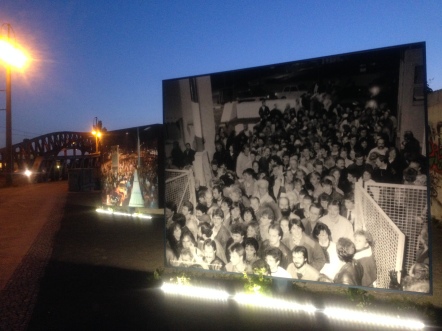
Bösebrücke. A memorial plaque and some giant photographs marked the spot where 20,000 people crossed from East Berlin into West Berlin on the 8th and 9th of November 1989, a month before Jenny and I got there, the start of the mass civil disobedience that saw the end of the East German state. Heroes just for one day.
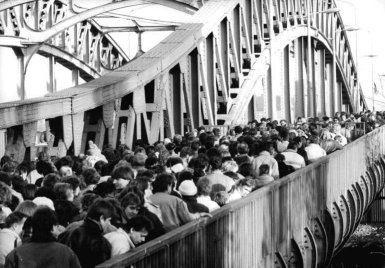
The bridge glowed with yellow lights in the deep blue dusk. My heart filled with feeling. So David’s song took Berlin as a starting point to measure this world of ours, his own ch-ch-changes, the passing of time, and ask what it all meant. Others have said that “Where are we now?” actually means “Where am I now?” but I disagree – Bowie is never shy to put himself at the centre of his songs, using “…I could do that” for example, in the first verse here. No, he means – where are we now ? Not just Berliners, not just him, but all of us.
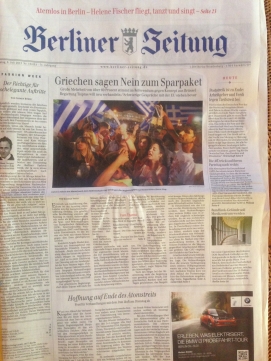
On the morning that I made this pilgrimage through Bowie’s Berlin the newspapers all had the same headline : “Griechen sagen Nein“. The bailout terms from the European Central Bank – more austerity, further cuts to pensions, wages and public institutions – had been rejected by the Greek people by 61%- 38%. News had just come over – we had five years left to cry in… Europe has unified since 1978, when David Bowie sang
“I, I can remember.. standing…by the Wall,
with the guns shot above our heads, and we kissed as if nothing could fall…
and the shame was on the other side…oh we can beat them for ever and ever…“
(Incidentally the German-language version of “Heroes” “Helden” is magnificent, and probably more passionate than the cooler English-language song. It is also worth pointing out that “Heroes“ always has quote marks around it, giving us instant irony).
By 2013 previous communist regimes had fallen and joined the EU, including Poland, Hungary, Romania, Bulgaria, the Czech Republic and Slovakia, all the Baltic states of Latvia, Lithuania and Estonia, East Germany and West Germany had become Germany and the Euro had become the currency ideal of those who believed in the United States of Europe – a dream of trade co-operation, one currency, no borders, movement of workers and capital across the continent, a rival to the USA, to China, a bastion of democracy and liberal capitalism. Hmmm. Instead we now have a two or three-tier system, southern Europe has a very different economic outlook than the north (or maybe there will be a domino effect…) – not just Greece, but Italy, Spain and Portugal have economies and national debts which challenge the democratic fantasies of the most ardent Europhile. And it seemed to me reading those headlines yesterday that while some things had “changed”, really : where are we now? Retired schoolteachers in Athens – people who served and taught schoolchildren all their lives – are begging on the streets, alongside whole families.
…the moment you know, you know you know…
These are the 2008 Crash chickens coming home to roost, and it is divide and rule – we bailed out the banks to the tune of billions, we bailed out Germany’s war debts in the 1950s, but we can’t bail out Greek pensioners and families begging on street corners. This is the sharp end of capitalism in 2015 and it is an ugly sight. Think of us as fatherless scum and it won’t be forgotten... Looking out from Berlin as David’s late-period masterpiece still hangs in the air, it seems to me that Greece is the new DDR. We have to look down our snouts at somebody. Capitalism doesn’t appear to work without someone losing out – which means haves and have-nots, economic migrants, austerity packages while those who run our lives get increasingly large bonuses.
…It’s the theatre of financiers
Count them, fifty ’round a table
White and dressed to kill…
A large dose of reality. But as David can make you feel bleak, he can reaffirm life too, and this is a song that does both…
…as long as there’s sun….as long as there’s sun
…as long as there’s rain…as long as there’s rain
…as long as there’s fire….as long as there’s fire…
…as long as there’s me….as long as there’s you…
We’ll be all right. Won’t we ?
Right at the end of the video we see David Bowie approaching his 66th birthday wearing a T-shirt that says m/s Song Of Norway. Actually a cruise ship T-shirt, it is also the name of a film made in 1970 that his girlfriend – Hermione Farthingale – left him to be involved with. Apparently David never got over it. Here is a man who spent his entire artistic life being a spaceman, a starman, a thin white duke, aladdin sane, a fervent embracer of the future looking back at his life as a human. It is a beautiful piece of work.
Ain’t there one damn song that can make me
Break down and cry?
Jul 08, 2015 @ 15:08:24
Another visual thought provoking blog.I like the song a lot maybe even love it .
It captures a lot says a lot takes you back to your own light and life
or lack of it on your journey through the heart and this life and the brief span of time we are here always did doling shining fading disappearing from first breath.Waling the dead as you know is one of my theme sin Te Magic Hand written 50 years ago.The dEad are walking down the street .Bowie for me brings back my memories
of deflating nature of matter and how you can not hold int o anything.I love you descriptions and narrative and how deep you go into al the aspects of the musicians the meanings of their verse and notes .o i say you can hold on to nothing so enjoy while you are passing through and certainly Bowie conveys so much of this in his artistry for me. Thank you for doing these Ralph they are stimulating and even a geezer like me draws much benefit .You are sweet creative soul and i mis sigher presence .Peopel fad e in handout of our live si hope you are one who will stay in mine love stevie
LikeLiked by 1 person
Jan 11, 2016 @ 19:59:09
I still love this so much as i live you two .Blessings .This is on of my favorite songs love Stevie
LikeLiked by 1 person
Jan 11, 2016 @ 20:02:54
15:08:24
Another visual thought provoking blog.I like the song a lot maybe even love it .
It captures a lot says a lot takes you back to your own light and life
or lack of it on your journey through the heart and this life and the brief span of time we are here always shining fading disappearing from first breath.Walking the dead as you know is one of my themes in The Magic Hand written 50 years ago.The dead are walking down the street .Bowie for me brings back my memories
of the deflating nature of matter and how you can not hold onto anything.I love your descriptions and narrative and how deep you go into all the aspects of the musicians the meanings of their verse and notes .I say you can hold on to nothing so enjoy while you are passing through and certainly Bowie conveys so much of this in his artistry for me. Thank you for doing these Ralph they are stimulating and even a geezer like me draws much benefit .You are sweet creative soul and i miss your presence .People fade in and out of our live i hope you are one who will stay in mine love stevie
LikeLike
Jan 11, 2016 @ 20:03:33
I tried to correct most of the typos I love this song
LikeLiked by 1 person